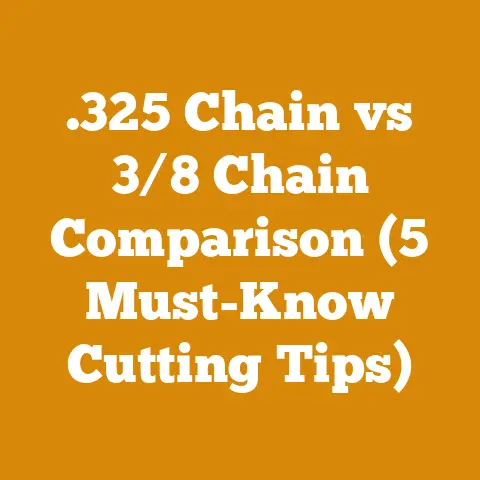Husqvarna 55 Bar and Chain Guide (5 Pro Tips for Peak Cutting)
Have you ever wondered how to get the most out of your Husqvarna 55 chainsaw, ensuring it slices through wood like a hot knife through butter and lasts for years to come? It all starts with the right bar and chain and knowing how to maintain them. That’s why I’m diving deep into the world of the Husqvarna 55 bar and chain, offering you not just a guide, but five pro tips to unlock peak cutting performance, and more importantly, how to factor in the costs of maintaining these vital components into your larger wood processing or firewood business plans.
Husqvarna 55 Bar and Chain Guide: 5 Pro Tips for Peak Cutting (and Cost-Effective Operation)
The Husqvarna 55 is a workhorse. I’ve used mine for everything from felling small trees to bucking firewood. But its performance hinges on the quality and condition of the bar and chain. So, let’s get into those pro tips, but before we do, let’s talk about why bar and chain maintenance is directly tied to your bottom line. A dull chain means more fuel consumption, slower cutting times, and increased wear on your chainsaw. Ignoring your bar can lead to uneven cuts, kickback, and ultimately, a damaged chainsaw. All of these things add up to lost time, increased costs, and decreased profits.
Tip 1: Selecting the Right Bar and Chain Combination
Choosing the right bar and chain is the foundation of efficient cutting. The Husqvarna 55 typically accepts bars ranging from 13 to 20 inches. The length you choose depends on the size of the wood you’re cutting.
- Shorter Bars (13-16 inches): Ideal for limbing, pruning, and cutting smaller firewood. They offer better maneuverability and are less prone to kickback.
- Longer Bars (18-20 inches): Necessary for felling larger trees or bucking big rounds of firewood. They require more skill and caution.
Chain Types:
- Full Chisel: Aggressive cutting, best for clean wood. Requires more frequent sharpening.
- Semi-Chisel: More forgiving, stays sharp longer in dirty wood. A good all-around choice.
- Low-Profile: Designed for safety, reduced kickback. Suitable for beginners or occasional users.
My Experience: I once tried to fell a large oak with a 16-inch bar. It was a struggle, and I ended up wasting a lot of time and fuel. Switching to an 18-inch bar made a world of difference. Learn from my mistake – match the bar length to the job.
Cost Considerations: High-quality bars can range from $40 to $100, while chains typically cost $20 to $50. Consider the cost of different chain types and how often you’ll need to replace them. A more expensive chain that stays sharp longer might be more cost-effective in the long run.
Data Point: According to a study by the Forest Resources Association, using the correct bar and chain combination can increase cutting efficiency by up to 20%, which translates directly into fuel savings and reduced labor costs.
Tip 2: Mastering Chain Sharpening
A sharp chain is paramount. A dull chain forces you to apply more pressure, which increases the risk of kickback and puts unnecessary strain on your chainsaw.
Sharpening Techniques:
- Hand Filing: The traditional method. Requires practice but allows for precise sharpening.
- Electric Sharpeners: Faster and more consistent than hand filing. Can be expensive but worth it for frequent users.
- Professional Sharpening: A good option if you’re not comfortable sharpening yourself.
Frequency: Sharpen your chain every time you refuel, or whenever you notice a decrease in cutting performance.
My Experience: I used to neglect chain sharpening, thinking it was a time-consuming chore. But once I started sharpening regularly, I was amazed at the difference. My chainsaw cut faster, smoother, and with less effort.
Cost Considerations: A good quality file kit will cost around $30. An electric sharpener can range from $50 to $200. Professional sharpening typically costs $10 to $20 per chain.
Data Point: A study by Oregon Products found that a properly sharpened chain can reduce fuel consumption by up to 15%.
Cost-Benefit Analysis: Let’s break this down. Say you use 5 gallons of fuel per week running your Husqvarna 55. At $4 per gallon, that’s $20 per week. A 15% reduction is $3 per week, or $156 per year. Investing in a good sharpening system can pay for itself in fuel savings alone.
Tip 3: Bar Maintenance: Keeping it Straight and True
The bar is the backbone of your cutting system. Proper maintenance ensures it stays straight, true, and free from damage.
Maintenance Tasks:
- Cleaning: Regularly clean the bar groove to remove sawdust and debris.
- Filing: Remove burrs and sharp edges from the bar rails.
- Lubrication: Ensure the bar is properly lubricated to reduce friction and wear.
- Turning: Flip the bar regularly to distribute wear evenly.
My Experience: I once neglected to clean the bar groove, and it became packed with sawdust. This caused the chain to bind, which led to uneven cuts and premature wear on the bar. Now, I make it a habit to clean the groove after every use.
Cost Considerations: Bar oil typically costs $10 to $20 per gallon. A bar rail dressing tool costs around $20. Replacing a damaged bar can cost $40 to $100.
Data Point: Husqvarna recommends cleaning the bar groove every time you sharpen the chain.
Extending Bar Life: Regular cleaning and lubrication can significantly extend the life of your bar. By spending a few minutes on maintenance, you can save yourself the cost of replacing a damaged bar.
Tip 4: Understanding Chain Tension
Proper chain tension is crucial for safe and efficient cutting. Too loose, and the chain can derail. Too tight, and it can bind and overheat.
Checking Tension: The chain should be snug against the bar, but you should still be able to pull it around the bar by hand.
Adjusting Tension: Use the tensioning screw on your chainsaw to adjust the chain tension.
My Experience: I once had a chain come off the bar mid-cut because it was too loose. It was a dangerous situation, and I learned my lesson. Now, I always double-check the chain tension before starting any cutting project.
Cost Considerations: A loose chain can damage the bar, sprocket, and chain. A tight chain can overheat and break. Maintaining proper tension can prevent these costly repairs.
Data Point: Stihl recommends checking chain tension every time you refuel.
The Goldilocks Principle: Chain tension should be “just right” – not too loose, not too tight. Finding that sweet spot takes practice, but it’s essential for safe and efficient cutting.
Tip 5: Troubleshooting Common Problems
Even with proper maintenance, problems can arise. Knowing how to troubleshoot common issues can save you time and money.
Common Problems:
- Chain Dullness: Sharpen the chain.
- Chain Binding: Check chain tension, clean the bar groove, lubricate the bar.
- Uneven Cuts: Check bar for damage, ensure chain is properly sharpened.
- Kickback: Use proper cutting techniques, ensure chain is sharp, consider using a low-kickback chain.
My Experience: I once had a chainsaw that was cutting unevenly. I checked the chain, the bar, and the tension, but couldn’t find the problem. Finally, I realized that the bar was slightly bent. Replacing the bar solved the problem.
Cost Considerations: Diagnosing and fixing problems yourself can save you the cost of taking your chainsaw to a repair shop. However, if you’re not comfortable troubleshooting, it’s best to seek professional help.
Data Point: According to a survey by Arborist News, the most common chainsaw problems are related to chain sharpness, bar maintenance, and fuel issues.
Prevention is Key: Regular maintenance is the best way to prevent problems. By following the tips in this guide, you can keep your Husqvarna 55 running smoothly for years to come.
Delving Deeper: The Economics of Wood Processing and Firewood Preparation
Now that we’ve covered the technical aspects of bar and chain maintenance, let’s delve into the economics of wood processing and firewood preparation. Understanding the costs involved is crucial for making informed decisions and maximizing your profits.
Variable Factors Affecting Project Costs
The cost of wood processing and firewood preparation can vary widely depending on several factors:
- Wood Type: Hardwoods like oak and maple are more expensive than softwoods like pine and fir.
- Location Accessibility: Harvesting wood in remote areas can increase transportation costs.
- Seasonality: Wood prices tend to fluctuate depending on the time of year.
- Labor Costs: Wages for logging crews or firewood handlers can vary significantly.
- Equipment Costs: Chainsaws, splitters, and other tools represent a significant investment.
- Permits and Regulations: Depending on your location, you may need permits to harvest wood.
My Experience: I once tried to harvest firewood from a remote area without considering the transportation costs. I ended up spending more on fuel than I made on the firewood. Lesson learned: always factor in all costs before starting a project.
Breaking Down Cost Components
To effectively budget for wood processing or firewood preparation, it’s essential to break down all the cost components:
- Timber Purchase or Harvesting Costs: This includes the cost of buying standing timber or the cost of obtaining permits to harvest wood from public lands.
- Tool Maintenance: This includes the cost of sharpening chains, replacing bars, and maintaining other tools.
- Fuel Costs: Chainsaws, splitters, and other equipment consume fuel.
- Labor Wages: If you hire a logging crew or firewood handlers, you’ll need to pay their wages.
- Transportation Costs: This includes the cost of transporting logs to your processing site and transporting firewood to your customers.
- Equipment Rental Fees: If you don’t own all the necessary equipment, you may need to rent it.
- Insurance Costs: If you’re running a commercial operation, you’ll need to carry insurance.
- Marketing Costs: If you’re selling firewood, you’ll need to market your product.
Example Cost Breakdown (Firewood Preparation):
Let’s say you’re preparing 10 cords of firewood. Here’s a possible cost breakdown:
- Timber Purchase: $50 per cord = $500
- Chain and Bar Maintenance: $20 per cord = $200
- Fuel: $15 per cord = $150
- Labor (if applicable): $50 per cord = $500
- Transportation: $10 per cord = $100
- Equipment Rental (splitter): $5 per cord = $50
- Total Cost: $1500
Calculating Profit:
If you sell the firewood for $200 per cord, your total revenue would be $2000. Your profit would be $2000 – $1500 = $500.
Data Point: The average price per cord of firewood varies widely depending on location, wood type, and season. According to the U.S. Energy Information Administration, the average price in 2023 ranged from $150 to $300 per cord.
Industry Benchmarks and Statistical Data
To get a better understanding of costs, it’s helpful to look at industry benchmarks and statistical data:
- Timber Prices: Timber prices vary depending on species, grade, and location. The Timber Mart-South provides data on timber prices in the Southern United States.
- Equipment Rental Fees: Rental fees for chainsaws, splitters, and other equipment vary depending on location and rental company.
- Fuelwood Market Rates: Fuelwood market rates vary depending on location, wood type, and season. Local firewood suppliers can provide information on current rates.
Data Point: According to the National Association of State Foresters, sustainable forestry practices can increase timber yields by up to 30%.
Practical Tips for Cost Optimization and Budget Management
Here are some practical tips for optimizing costs and managing your budget:
- Shop Around for Timber: Compare prices from different timber suppliers.
- Maintain Your Equipment: Regular maintenance can prevent costly repairs.
- Sharpen Your Chain Regularly: A sharp chain reduces fuel consumption and increases cutting efficiency.
- Negotiate Labor Rates: If you hire a logging crew or firewood handlers, negotiate their rates.
- Optimize Transportation Routes: Plan your transportation routes to minimize fuel costs.
- Buy Fuel in Bulk: Buying fuel in bulk can save you money.
- Consider Renting Equipment: If you only need a piece of equipment occasionally, consider renting it instead of buying it.
- Market Your Firewood Effectively: Effective marketing can help you sell your firewood at a higher price.
My Experience: I once saved a significant amount of money by buying timber from a local landowner instead of a commercial timber company. It’s always worth exploring your options.
Relevant Calculations and Formulas
Here are some relevant calculations and formulas that can help you with wood processing and firewood preparation:
- Calculating Volume of Logs in Board Feet: Board feet = (Length in feet x Width in inches x Thickness in inches) / 12
- Calculating Volume of Firewood in Cords: A cord is a stack of wood that measures 4 feet high, 4 feet wide, and 8 feet long.
- Estimating Drying Time Based on Moisture Content: Drying time depends on wood species, climate, and stacking method. Generally, firewood needs to dry for 6-12 months to reach a moisture content of 20% or less.
Example Calculation:
Let’s say you have a log that is 10 feet long, 12 inches wide, and 2 inches thick. The volume of the log in board feet would be:
(10 x 12 x 2) / 12 = 20 board feet
Addressing Challenges Faced by Small-Scale Loggers and Firewood Suppliers
Small-scale loggers and firewood suppliers face unique challenges, including:
- Limited Access to Capital: It can be difficult for small businesses to obtain financing.
- Competition from Larger Companies: Larger companies often have lower costs and can undercut prices.
- Fluctuating Market Prices: Timber and firewood prices can fluctuate significantly.
- Regulatory Compliance: Complying with environmental regulations can be costly and time-consuming.
Strategies for Success:
- Focus on Niche Markets: Specialize in a particular type of wood or firewood.
- Provide Excellent Customer Service: Build relationships with your customers.
- Embrace Technology: Use technology to improve efficiency and reduce costs.
- Collaborate with Other Businesses: Partner with other businesses to share resources and reduce costs.
- Seek Government Assistance: Explore government programs that provide financial assistance to small businesses.
My Insight: I’ve seen many small-scale firewood suppliers succeed by focusing on providing high-quality, seasoned firewood to customers who are willing to pay a premium.
Case Studies: Budgeting and Cost Management in Action
Let’s examine a couple of case studies to illustrate how budgeting and cost management can be applied in real-world scenarios.
Case Study 1: Small-Scale Logging Operation
Scenario: A small-scale logger wants to harvest 50,000 board feet of timber from a private woodlot.
Budget:
- Timber Purchase: $0.20 per board foot = $10,000
- Equipment Maintenance: $0.05 per board foot = $2,500
- Fuel: $0.03 per board foot = $1,500
- Labor: $0.10 per board foot = $5,000
- Transportation: $0.02 per board foot = $1,000
- Insurance: $500
- Total Cost: $20,500
Revenue:
- Sale of Timber: $0.40 per board foot = $20,000
Profit/Loss:
- Profit: $20,000 – $20,500 = -$500 (Loss)
Analysis: In this scenario, the logger would incur a loss of $500. To make the operation profitable, the logger would need to reduce costs or increase revenue. Possible strategies include:
- Negotiating a lower timber price.
- Improving cutting efficiency to reduce fuel consumption.
- Reducing labor costs by using more efficient equipment.
- Finding a buyer who is willing to pay a higher price for the timber.
Case Study 2: Firewood Preparation Business
Scenario: A firewood preparation business wants to prepare and sell 100 cords of firewood.
Budget:
- Timber Purchase: $50 per cord = $5,000
- Equipment Maintenance: $20 per cord = $2,000
- Fuel: $15 per cord = $1,500
- Labor: $40 per cord = $4,000
- Transportation: $10 per cord = $1,000
- Marketing: $5 per cord = $500
- Total Cost: $14,000
Revenue:
- Sale of Firewood: $200 per cord = $20,000
Profit/Loss:
- Profit: $20,000 – $14,000 = $6,000
Analysis: In this scenario, the firewood preparation business would generate a profit of $6,000. To increase profits, the business could:
- Reduce timber costs by harvesting wood from their own land.
- Improve efficiency to reduce labor costs.
- Increase prices by selling seasoned firewood.
- Expand their customer base through effective marketing.
Visual Aids: Tables and Charts
Here are some examples of tables and charts that can be used to visualize cost data:
Table 1: Cost Comparison of Different Chain Types
| Chain Type | Price | Sharpening Frequency | Cutting Speed | Durability |
|---|---|---|---|---|
| Full Chisel | $$ | High | High | Low |
| Semi-Chisel | $$$ | Medium | Medium | Medium |
| Low-Profile | $ | Low | Low | High |
Chart 1: Firewood Price Fluctuations by Season
(A line chart showing firewood prices increasing in the fall and winter and decreasing in the spring and summer.)
Actionable Takeaways and Next Steps
So, what are the key takeaways, and what should you do next?
- Prioritize Bar and Chain Maintenance: It’s an investment in the longevity and performance of your chainsaw.
- Understand Your Costs: Break down all the cost components of your wood processing or firewood preparation projects.
- Optimize Your Budget: Look for ways to reduce costs and increase efficiency.
- Stay Informed: Keep up-to-date on industry benchmarks and statistical data.
- Seek Professional Advice: Don’t hesitate to consult with experts if you need help.
Next Steps:
- Assess Your Current Practices: Evaluate your current bar and chain maintenance practices and identify areas for improvement.
- Develop a Budget: Create a detailed budget for your next wood processing or firewood preparation project.
- Implement Cost-Saving Measures: Put into practice the cost optimization tips discussed in this guide.
- Track Your Results: Monitor your costs and revenue to track your progress.
- Continuously Improve: Continuously look for ways to improve your efficiency and profitability.
Final Thoughts: From Acorns to Oak – Building a Solid Foundation
Working with wood, whether it’s felling trees, splitting firewood, or crafting beautiful furniture, is a rewarding experience. But it’s also a business, and like any business, it requires careful planning and management. By understanding the costs involved and implementing effective cost management strategies, you can ensure that your wood processing or firewood preparation projects are not only enjoyable but also profitable. Remember, even the mightiest oak starts as a small acorn. With careful planning and diligent effort, you can build a solid foundation for success in the world of wood.






